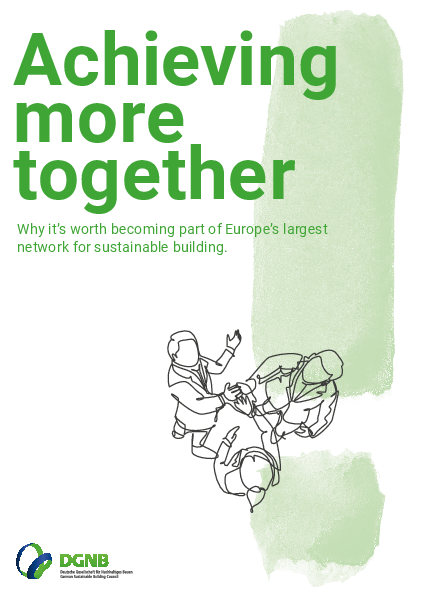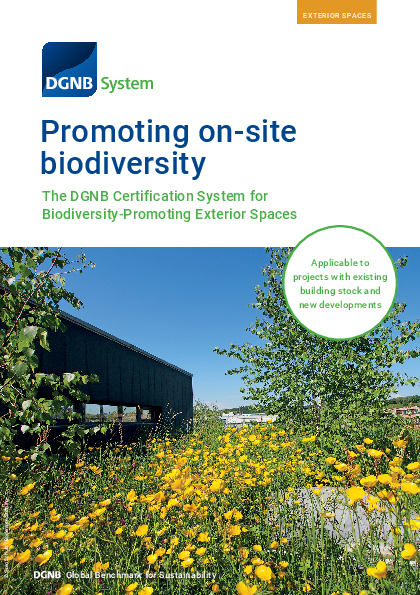DGNB background information
With our background information, we help to correctly classify current issues related to the DGNB – you can find them bundled here.
To the background information
DGNB publications on sustainable building in English

Focus on: Circular building
The aim of this document is to promote a common understanding of the concept of circular building such that as a strategy, it becomes an integral feature of every construction project. It should help all kinds of stakeholders in the building and property industry to think ahead when discussing and defining their individual goals and priorities for projects. It should also help align companies and organisations with the principles of the circular economy. Not only does this allow you to take a stand on the transformation that is now so urgently needed, it also enables you to play an active part in the practical application of circular building and its important contribution to sustainable building.
Market Insights: ESG adoption and implementation in EU construction and real estate
Report der CPEA EU ESG Working Group | The aims of the report are: To increase understanding of the background, meaning and relevance of ESG amongst market participants, examining ESG drivers, challenges and potential solutions. To stimulate cross-border and cross-disciplinary debate. To position ESG within the context of existing and forthcoming EU legislation and other industry-led initiatives. By featuring organisational case studies the report is illustrating what good practice implementation in construction and real estate can look like, focusing on how existing challenges can be overcome.
Guide to Climate Positive Building Stock
"Act now, remove barriers now, collaborate now" is the motto of the publication "Guide to Climate Positive Building Stock", which shows how building stock can become climate positive. It was developed as part of the EU project #BuildingLife. The first part of the brochure provides information on the status quo of building stock at policy level. Furthermore, it identifies 50 of the most important measures for a common path towards climate-positive building stock. The report is addressed at all stakeholders in the building and real estate sector, as well as decision-makers in local governments, science, politics and finance.
Circular Economy Taxonomy Study
The real estate sector is not prepared for the transition to a circular economy like it is specified by the European Union. This is shown by a study conducted by the DGNB together with European partners. In it, the marketability of the Circular Economy criteria of the EU taxonomy was examined on the basis of real construction projects. The resource conservation taking place today through the reuse of building components and the use of recyclates proved to be particularly challenging. In addition, there was a lack of data and methods for circular building. 38 projects of different building types from ten different countries participated in the study.
Building Materials and Sustainability
The building materials selection has a major influence on the overall result of a sustainable building. But what really matters when it comes to choosing materials? And what information is really relevant, far from trends and marketing statements? The report "Building materials and sustainability" provides planners and builders with principles and methods to guide them in their material decisions. At the same time, it creates a basis for communication with building product manufacturers. In a compact form with numerous graphics, checklists and a selection of building material alternatives, it motivates implementation.
EU Taxonomy Study: Climate change mitigation
The property market has quite a bit of catching up to do if it wants to work through the taxonomy criteria laid down by the European Union. This is partially because stakeholders lack the information they need to fulfil verification requirements. In addition, the way some of the criteria are currently formulated, they are practically impossible to fulfil. This is the conclusion of a recent study conducted by the DGNB in collaboration with partners from Denmark, Austria and Spain. It also includes concrete recommendations to the EU Commission and market stakeholders aimed at making it easier to apply the criteria in the future.
Building for a better world
The publication "Building for a better world" shows how buildings can contribute to the UN Sustainable Development Goals (SDGs). It introduces the reader to the topic of sustainable development and highlights that up to 15 SDGs are addressed through sustainable construction. Using the example of erecting new buildings, using and operating buildings and developing districts, the report shows that the DGNB certification system can be used as a planning tool to translate the SDGs into real projects. Sustainable development thus becomes tangible.
Framework for carbon neutral buildings and sites
In the Framework, the DGNB has compiled its definition of carbon neutrality as well as the corresponding explanations regarding procedures. The aim is to create clarity on the market and to educate all stakeholders with regard to effective optimisation approaches for reducing the CO2 emissions of their properties. Among other things, the Framework describes the rules for CO2 accounting of buildings and sites. It also serves as a basis for developing building-specific climate action strategies. Additionally, requirements and possibilities for CO2 reporting and quality assurance are presented.
Climate positive: now!
The publication "Climate positive: now!" shows how every building can make a contribution to climate protection and offers assistance in the form of pragmatic and practical implementation. It provides more detailed background information on why the construction and real estate sector plays a central role in climate protection and why a paradigm shift is needed in the way we treat our buildings. In addition, areas of action are named that have a significant influence on making buildings climate-neutral.
Added value of certified buildings
For occupants, but also for building owners and investors, sustainable buildings offer a myriad of benefits – from avoiding hazardous materials to achieving lower incidental costs while the building is in use, plus long-term value retention on the building. For the first time, a survey has now been conducted to explore why such factors are important for building commissioners and to examine the experiences they had when gaining DGNB certification. To do this, a questionnaire was written as part of a supervised student thesis at the University of Maastricht. It was then sent to clients who had commissioned DGNB building certification in the past.
Liveable and fit for the future
We spend up to 90 percent of our time in buildings. We live, learn and work in them, we have contact with our fellow humans, seek shelter from external influences, and in the best case they provide us with space for recuperation. Yet, do people really take account of this central role during the design of buildings or their conversion? This publication creates a bridge: Between the designers and architects with their ideas and their expert knowledge on the one side, to the people who have the responsibility of making sure that employees and customers, residents and guests, students and school pupils, have an adequate working, living, and learning environment.
The cost traps of refrigerants
In order to design and build for the future, DGNB wanted to inform building owners and planners about the use of refrigerants and organised an information event in June 2018 in Berlin. The results of the event are summarised in this publication.
Circular Economy
In recent years the term "circular economy" has become more widespread and has also become a relevant topic in construction. The concept upon which the circular economy is based has great potential: The availability of resources should be ensured for future generations through their appreciation, as well as reuse and recovery. The circular economy is therefore an elementary building block of sustainability and it transfers sustainability to society and its individual sectors.
Keep an overview of sustainable building
This brochure explains the function and application of the construction product platform DGNB Navigator. The DGNB Navigator combines the information offer from the manufacturers with the enquiries of designers on the one platform. Furthermore, it represents an important bridge between construction products and the DGNB certification system for buildings, in that it provides the requested data for the building's certification in accordance with DGNB.
NO MORE EXCUSES – Sustainable is the new normal
The fact that our current lifestyle is not doing our environment any good isn't breaking news at the time of this current IPCC report. When it comes to actively applying solutions, however, too many people hide behind the two small words: "yes" and "but". Why it is time to turn this "yes, but" into a "yes, count me in!", and how this can succeed is addressed in this publication. It clears up the most common prejudices about sustainable building and vividly demonstrates why sustainable construction is essential.
Life Cycle Assessment – a guide on using the LCA
These guidelines aim to promote the increased use of life cycle assessments in the planning process, by demonstrating the relevance and potential of this tool. Designers and building contractors are additionally provided with arguments for employing these methods as an optimisation tool as early as possible in the planning and implementation process, and the sustainability effects that can be achieved as a result of this are emphasised. Furthermore, the reader is presented with examples of how the results of life cycle assessments are communicated and can serve as supporting arguments for making more environmentally sensible decisions in the course of the planning process.
Added value of certified districts
The DGNB can certify urban districts, business districts, vertical cities, resorts and open event areas. The DGNB is also the world's only provider of certifications for industrial sites. The added value that sustainable planning and implementation as well as certification offers has now been ascertained by a survey. The study was developed as a part of a thesis at the University of Biberach, for which questionnaires were sent to all of DGNB's current and former clients, DGNB auditors and participating planners.
Brochures and flyers on DGNB products in Englisch


Promoting on-site biodiversity
Brochure on the DGNB System for Biodiversity-Promoting Exterior Spaces
Making existing buildings future-proof
Brochure on the DGNB System for Buildings In Use
Sustainable quality in series
Brochure on DGNB Multiple and Serial Certification
Planning, building and operating buildings sustainably
Brochure on the DGNB System
Your contacts
Felix Jansen
Director PR, Communications and Marketing
- Phone: +49-711-722322-32
- Email: F.JANSEN@DGNB.DE

